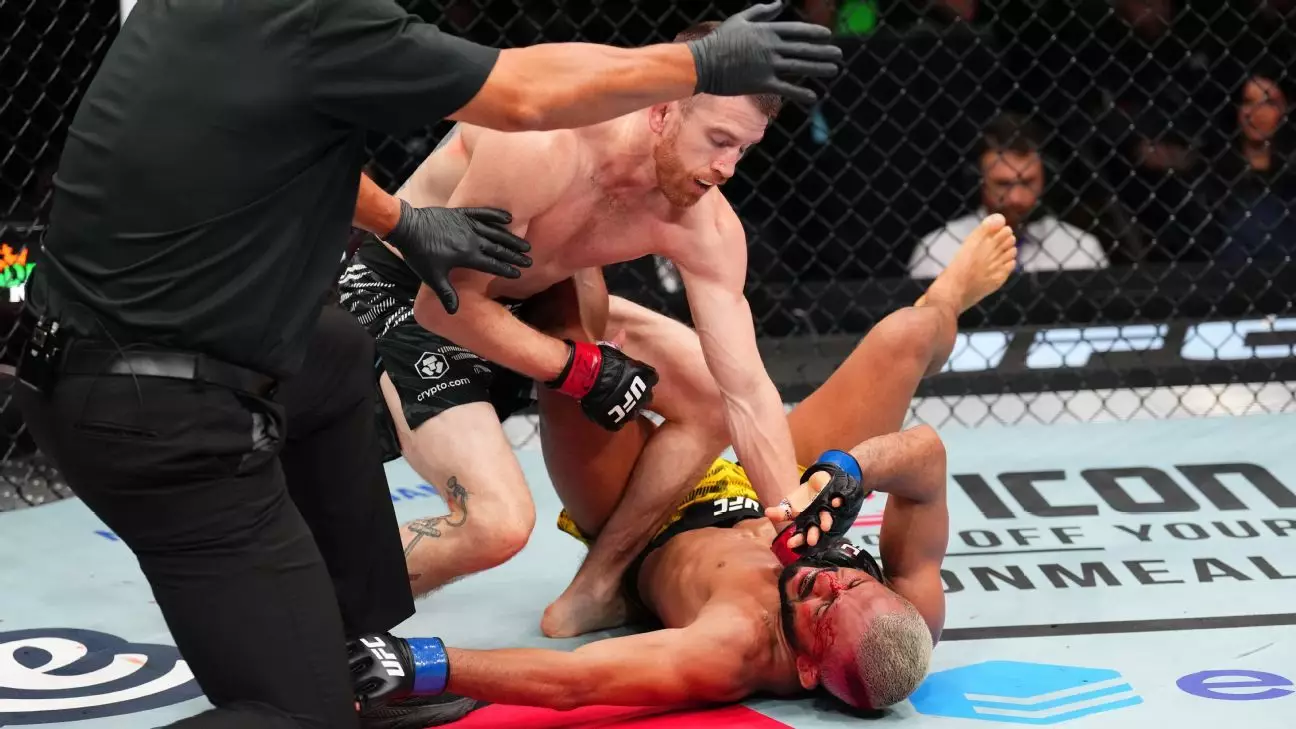Cory Sandhagen’s recent fight against Deiveson Figueiredo not only marks a significant turning point in his career but also serves as an emblem of resilience and relentless ambition. At 33, the Aurora, Colorado native demonstrated his striking prowess and strategic intelligence in the Octagon, asserting control and earning a second-round TKO. Sandhagen’s victory is a refreshing reminder of the tenacity required to break through in the unforgiving arena of Mixed Martial Arts (MMA), where every win is a footstep closer to championship glory.
Having faced setbacks, including a loss to Umar Nurmagomedov in a title eliminator last August that interrupted a three-fight winning streak, Sandhagen has proven he possesses both skill and mental fortitude. The ability to bounce back from defeats is what separates champions from challengers. While critics might argue that the fight’s conclusion was less than ideal, primarily due to Figueiredo’s tactical blunder, Sandhagen capitalized on the moment—not only asserting his dominance but also sending a clear message to the bantamweight division: he is not to be underestimated.
The Dynamics of Figueiredo’s Strategy
Analyzing Figueiredo’s approach provides valuable insights into the psychological and strategic dimensions of high-stakes competition. His decision to attempt a leg lock early on, which was later duplicated in the second round, seemed to stem from an overconfidence in grappling. This risky maneuver laid the groundwork for Sandhagen’s onslaught, where he unleashed a series of devastating punches and elbows. To the casual observer, it might appear that Figueiredo was merely unlucky, but his choices reflect a deeper issue—perhaps a lapse in understanding the 50-50 position, a cornerstone in Brazilian jiu-jitsu that can dictate the outcome of grappling exchanges.
Sandhagen’s comments following the fight reflect a blend of humility and ambition. While he acknowledges the unfortunate nature of Figueiredo’s injury, he doesn’t shy away from pointing out the importance of grappling proficiency. This perspective underscores that success in MMA is not merely about physicality; it’s about understanding the nuances and intricacies that can either propel you to greatness or lead to downfall.
Looking Forward: A Title Shot Awaits
From here, Sandhagen’s sights are set firmly on the championship belt, with a potential showdown against the winner of the highly anticipated match between Merab Dvalishvili and Sean O’Malley. His aspirations are not just for glory; they resonate with a deeper longing to prove himself on a grand stage. He voiced this passionately, stating, “I’ve dreamed of being a world champion for more than half of my life now.” This fervor is inspiring—and it speaks volumes about Sandhagen’s character.
In order to step into the cage as a champion, he must not only prepare for the physical demands of his next opponent but also navigate the psychological pressures that come with the title fight. The bantamweight division is teeming with talent, and each fighter has their unique style and strengths. For Sandhagen, success will hinge not just on physical prowess but on crafting game plans that exploit his opponent’s weaknesses while bolstering his own strengths.
A Shifting Landscape in the Bantamweight Division
The bantamweight division is ripe with narratives, each fight contributing to an ongoing saga filled with dramatic turns and unexpected developments. Sandhagen’s journey is intertwined with his competitors’ tales, such as Figueiredo, who now faces questions after suffering consecutive losses. While Sandhagen propels himself forward, Figueiredo’s path may take him in a different direction as he reassesses his strategies and mentality following this setback.
Moreover, the co-main event showcased the resilience of other fighters, like Bo Nickal, who faced his first professional defeat against Reinier de Ridder. The dynamics of competition can shift rapidly, making every match more than just a contest of skill—a revelation of character and adaptability.
As the bantamweight division evolves, each fighter must remain vigilant, continually adjusting to the changing landscapes of their opponents and the sport itself. For Sandhagen, the future looks bright, but the journey to the belt will undoubtedly be fraught with challenges that will test every aspect of his training and mental preparation.
With every victory, Sandhagen solidifies his place among the elite fighters—an exciting prospect for fans and a daunting challenge for his opponents. The Octagon has a way of reshaping destinies, and as Sandhagen steps closer to achieving his lifelong dream of championship glory, it’s clear he’ll leave no stone unturned.

